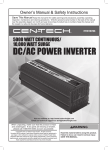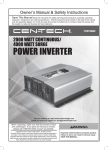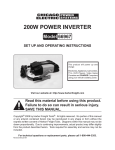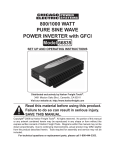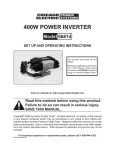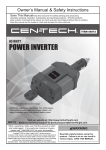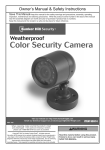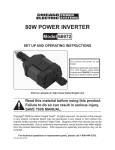Download CHICAGO 66817 Specifications
Transcript
Table of Contents Safety Safety.......................................................... 2 Specifications.............................................. 5 Setup........................................................... 6 Operation..................................................... 7 Maintenance............................................... 10 Parts List and Diagram................................ 2 Warranty..................................................... 11 WARNING SYMBOLS AND DEFINITIONS This is the safety alert symbol. It is used to alert you to potential personal injury hazards. Obey all safety messages that follow this symbol to avoid possible injury or death. Setup Indicates a hazardous situation which, if not avoided, will result in death or serious injury. Indicates a hazardous situation which, if not avoided, could result in death or serious injury. Indicates a hazardous situation which, if not avoided, could result in minor or moderate injury. Addresses practices not related to personal injury. Operation Important Safety Information Read all safety warnings and instructions. Failure to follow the warnings and instructions may result in electric shock, fire and/or serious injury. Save all warnings and instructions for future reference. General Precautions Maintenance 1. People with pacemakers should consult their physician(s) before use. Electromagnetic fields in close proximity to heart pacemaker could cause pacemaker interference or pacemaker failure. 2. WARNING: The brass components of this product contain lead, a chemical known to the State of California to cause birth defects (or other reproductive harm). (California Health & Safety code § 25249.5, et seq.) Page 2 3. WARNING: This product contains or, when used, produces a chemical known to the State of California to cause cancer and birth defects or other reproductive harm. (California Health & Safety Code § 25249.5, et seq.) 4. The warnings, precautions, and instructions discussed in this instruction manual cannot cover all possible conditions and situations that may occur. It must be understood by the operator that common sense and caution are factors which cannot be built into this product, but must be supplied by the operator. For technical questions, please call 1-800-444-3353. Item 66817 1. Do not install this inverter into a building’s electrical system. This inverter is a vehicular accessory. It is not designed to be safely used in a building’s electrical system and has not been evaluated to meet building wiring codes. Improper application may create a fire or electric shock hazard. 7. Keep inverter dry and clean. Do not expose to rain, snow, spray, bilge water or dust. 2. To allow proper cooling, install in indoor wellventilated area and do not cover ventilation openings or cooling fins. Do not install in engine compartment. Especially avoid placing the Inverter on carpets and rugs; they are not only flammable, but they also obstruct vents underneath it. 9. Mount inverter horizontally. 10. Verify that installation surface has no hidden utility lines before drilling or driving screws. 11. This product is not a toy. Keep it away from children. 12. Do not use with positive ground electrical systems. (Most automobiles, trucks, and RV’s have negative ground systems.) 4. Connect to 12 VDC power supply only. A power supply with lower voltage will not operate the Inverter correctly, and higher voltage could damage the unit. 13. The positive (+) battery on the Inverter must be the last connection made, and must be connected before the Inverter is turned on. There may be a small spark during the final connection. This is normal. 5. Connect input polarity properly. Incorrect connection will damage inverter and void warranty. 14. Properly ground the inverter’s case as explained in this manual. Setup 3. Keep combustible materials and gasses away from the inverter. The inverter produces sparks and heat during operation and can start a fire. 8. Install as close to DC source as possible, but not in a closed area with vented lead-acid batteries. Vented lead-acid batteries release explosive hydrogen gas that can be ignited by the inverter. Safety Installation Precautions 6. Do not use in a marine application. This inverter is not intended to withstand the highly corrosive conditions in marine applications and would quickly be rendered inoperable or unsafe. 1. Wear splash-resistant ANSI-approved safety goggles and electrically insulated gloves while working near batteries. 2. Charge, store, and maintain batteries according to supplier’s instructions. 3. Locate batteries in a clean, well-ventilated area, away from ignition sources and flammable materials. Vented lead-acid batteries release explosive hydrogen gas while charging. 4. Only connect similar batteries together. Do not connect old and new batteries together, wet and gel cells together, or batteries of different capacities together. 5. Use only 12 V batteries with this item. 6. Connect batteries in parallel ONLY (negative terminals together to one cable; positive terminals together to the other cable). Operation Battery Precautions 7. Install a properly rated fuse on the positive output of the battery bank. 1. Multiple outlet power strips with switches and circuit breakers only interrupt power to the “hot” receptacle terminals. The “neutral” terminals remain powered with respect to the “ground” terminals. So strip switch may be off, but part of appliance may still be powered. 2. Inspect supply connections before use to ensure they are tight and that insulation is not damaged. Item 66817 3. Do not use this inverter to power sensitive devices such as medical devices or computers. However, it may be used to charge a computer battery. Do not use in ignition protected areas. 4. Some rechargeable tools and appliances can damage the Inverter. Check the temperature of the device several times when it is charging. If the device becomes extremely hot; turn the power off, remove the device, and do not use with the Inverter again. For technical questions, please call 1-800-444-3353. Page 3 Maintenance Operation Precautions Operation Precautions (cont.) Safety 5. Check for breakage of parts and any other condition that may affect the Inverter’s operation. If damaged, have it repaired before use. 8. Do not attach a battery charger if the charger carries a warning that dangerous voltages are present at the battery terminals. 6. Do not attempt to power a device, or combination of devices, that will require more than the rated output of this inverter. This may damage the inverter or the attached devices. 9. Some fluorescent lamps may not operate properly with this type of inverter. If the bulb appears to be too bright, or fails to light, do not use the lamp with this inverter. 7. Appliances such as microwave ovens will normally draw more than their rated current. For example: A typical 600 watt microwave oven will draw approximately 1,000 watts. 10. Some fans with synchronous motors may slightly increase in speed when powered by the inverter. This is not harmful to the fan or to the inverter. 11. Inverter will consume some power while on, even without loads attached. Turn inverter off after use. Service Precautions Do not open housing. Contains no user-serviceable parts. Internal parts may be electrified, even with unit off and power disconnected. 1. Setup 2. Maintain labels and nameplates on the Inverter. These carry important safety information. If unreadable or missing, contact Harbor Freight Tools for a replacement. 3. Have your Inverter serviced by a qualified repair person using only identical replacement parts. This will ensure that the safety of the Inverter is maintained. 4. Fuses must be replaced with fuses of the same type and rating only. Save these instructions. Symbology Operation Double Insulated Canadian Standards Association Underwriters Laboratories, Inc. V~ Volts Alternating Current Direct Current Supply A Ø Amperes Phase Equipment Grounding Conductor Alternating Current Supply Maintenance Page 4 For technical questions, please call 1-800-444-3353. Item 66817 Input Voltage 12 VDC (nominal) Output Voltage 115 V~ / 60 Hz Continuous Power 750 W Surge Power 1500 W Operating Conditions 32° - 104° F Safety Specifications Two 3-prong grounded polarized AC outlets One 5 VDC 500mA USB outlet One 35 Amp Internal Blade-type Fuse (professional replacement only) Receptacles Fuse Type Overall Dimensions 9-1/4" L x 5-1/4" W x 2-1/2" H 12 10 10 10 8 8 8 6 6 16 14 12 10 10 8 8 8 6 6 6 16 14 10 10 8 8 6 6 6 6 4 16 14 10 10 8 8 6 6 6 4 4 16 14 10 8 8 6 6 6 4 4 4 14 14 10 8 6 6 6 4 4 4 4 14 14 10 8 6 6 6 4 4 4 4 14 12 8 8 6 6 4 4 4 4 4 14 12 8 8 6 4 4 4 4 4 2 14 12 8 8 6 4 4 4 4 2 2 1 2 3 16 4 14 5 6 7 8 14 9 12 10 20 30 12 Amp Load 40 50 60 10 80 8 8 90 100 6 6 10 8 70 4 6 4 4 2 Output Waveform Modified Sine Wave (MSW) Sine Wave 1. This inverter’s output is a Modified Sine Wave. Power from most electric utilities is a Sine Wave. Note: Only multimeters identified as “TRUE RMS“ will read Modified Sine Wave voltage accurately. Item 66817 2. Modified Sine Wave (MSW) power is suitable for most AC devices and power supplies used in electronic equipment, transformers, and motors. Do not use to power sensitive devices such as medical equipment or computers. Some audio equipment may perform poorly if run on Modified Sine Wave power. 3. Sine Wave inverters provide power that is identical to, or even better than, the power supplied by your power company. Motors start easier and run cooler under Sine Wave power. Certain devices, such as laser printers, variable speed motors and digital clocks, require sine wave power to operate properly. Sine wave inverters are typically more expensive for their capacity than other inverters. For technical questions, please call 1-800-444-3353. Setup 14 10 Page 5 Operation 16 5 Maintenance 1 2 3 4 5 6 7 8 9 10 Amp Load 5 10 20 30 40 50 60 70 80 90 100 Distance (yards) Distance (yards) 3069523 Installation Read the entire Important Safety Information section at the beginning of this manual including all text under subheadings therein before set up or use of this product. Safety TO PREVENT SERIOUS INJURY FROM ACCIDENTAL OPERATION: Make sure that the Power Switch is in the off‑position and unplug the tool from its electrical outlet before performing any procedure in this section. CAUTION! This Inverter must only be connected to batteries with a output voltage of 12 volts DC. Lower voltage will not operate the Inverter properly, and more voltage could damage the Inverter or the device being powered. Do not use this Inverter with positive ground electrical systems. Functions Power Inverter Power Terminals Setup The Inverter is configured to have a number of shut-down points, for the safety of the operator, the unit, and the devices being used with it. • If the DC input voltage drops too low, the alarm on the Inverter will sound. Should the input voltage drop further, the Inverter will shut down automatically to prevent permanent battery damage. Recharge the battery soon. Fan Power Button Fault LED Power LED • If the DC input voltage exceeds 15V the Inverter will shut down automatically. • If the output load power rises higher than the rating power of the Inverter; the unit may shut down automatically. Operation • The Inverter may automatically shut down if its internal temperature gets too high. Note: Even though this inverter has built-in mechanisms to minimize damage, the above situations should be avoided because they can still damage the inverter or battery. Alligator Clips Ring Terminals USB Outlet Power Outlets Figure 1 Cable Maintenance Page 6 For technical questions, please call 1-800-444-3353. Item 66817 Operating Instructions Read the entire Important Safety Information section at the beginning of this manual including all text under subheadings therein before set up or use of this product. Safety Tool Set Up TO PREVENT SERIOUS INJURY FROM ACCIDENTAL OPERATION: Make sure that all Power Switches/Triggers are in the off‑position and unplug the tool from its electrical outlet before performing any procedure in this section. 2. To connect the Cable Ring Terminals to the (Positive) red and (Negative) black Power Terminals on the back of the Inverter: a. Unthread the knobs covering the Power Terminals. b. Slide the red Cable’s Ring Terminal over the post of the red Power Terminal and the black Cable’s Ring Terminal over the post of the black Power Terminal. c. Replace the knobs and tighten securely. 3. Apply the parking brake to the vehicle connected to the battery. Place the transmission in “Park” for an automatic transmission, or in “Neutral” for a manual transmission. Start the car engine. Note: If the green LED fails to light and the alarm and red Fault LED lights up instead, check the Troubleshooting Tips section near the end of this manual to correct the issue before continuing. 6. To power each device or appliance: a. With the device or appliance switched off, plug it into one of the Power Outlets or the USB Outlet on the Power Inverter. b. Turn on the device and/or appliance. 7. After use, turn all connected devices or appliances off, unplug them, then turn off the car engine if it is running. Keep the inverter turned on and remove the alligator clips from the battery posts, removing the Negative (black) clip first, then the Positive (red) clip. The Inverter green LED will turn off, and the alarm and red LED light will turn on as the Inverter powers down. Turn off the Inverter power button. Maintenance 4. Attach the red Cable’s Alligator Clip to the Positive (red) terminal on the battery, then attach the black Cable’s Alligator Clip to a clean unpainted metal part of the chassis. (Note: If connecting to a battery not installed in a vehicle, connect to the Negative (black) terminal.) 5. The red Fault LED will light up momentarily and the alarm will sound as the Inverter draws power. Then the alarm and red LED will turn off and the green Power LED of the Inverter will light up. Operation 1. Place the Power Inverter on a flat surface. Make sure it has adequate ventilation and is not in direct sunlight. Locate the Inverter close enough to the car battery so that the Cables can easily reach between the Inverter and the car battery. Position the Inverter so that the Outlets are easily and safely accessible. Make sure the Inverter is in the OFF position. Setup Operating Instructions Item 66817 For technical questions, please call 1-800-444-3353. Page 7 Operating Tips The total wattage of all items plugged into the Power Inverter must not use more than 750 watts during continuous operation, otherwise the Inverter may overload. Safety If an alarm sound is heard, turn off the appliances and check the Troubleshooting Tips section to correct the issue before continuing. Caution: Some rechargeable appliances may damage the Power Inverter or the appliance. When first using a rechargeable device, check the inverter’s temperature for the first 10 minutes. If it becomes abnormally hot, do not use this device with the Inverter. Caution: It is recommended that the vehicle be running when you first connect the Power Inverter. Thereafter the engine can be on or off. If you run the Power Inverter with the engine off it is recommended that you start and run the engine every hour for at least 10 minutes to recharge the battery. Doing this will help prevent any unexpected shutdown of the equipment. This will also help ensure that there will be enough battery power to start the vehicle. Due to the risk of carbon monoxide inhalation, do not run the vehicle’s engine within an enclosed area. You should not use your car battery to power the Inverter for extended periods of time with appliances requiring high continuous load levels. The battery may become drained to the point that it will not be able to start your car. Note: Deep cycle (marine and RV) batteries can be charged more times than a car battery, and are a better choice for repeated use of the Power Inverter. Setup Do not discharge your car battery more than 10% of its total capacity, and deep cycle batteries more than a 50% discharged state. Typical Appliance Power Consumption Running Watts Additional Start-up Watts Stereo 200 0 Table Fan 200 200 TV-VCR 250 0 Small Refrigerator 350 700 Hand Drill - 1/2" 600 600 Light Bulb - 100 W 100 0 Microwave - 1000 W 1000 200 AC (5,000 BTU) 700 700 Product Operation Note:This chart is intended as a general guideline only, actual appliance wattage requirements will vary. Some appliances listed above may require a pure sine wave inverter instead for proper operation. Maintenance Page 8 For technical questions, please call 1-800-444-3353. Item 66817 Troubleshooting Tips If the alarm sounds, this means that the input voltage is at or below 10.9 V. The battery needs recharging. You should stop using the Power Inverter and recharge the battery. If this is not done, the Inverter will shut off automatically at 10.5 V. • If you are unsure if the inverter will have the proper amount of current to run your devices, add up the total of the continuous wattage for the items. If this figure is under 750 then the Inverter will be able to run the items at the same time. • If your product, such as a television will not start, it is important to keep in mind that some appliances (including many televisions) may require two to six times their wattage to start up. • If your audio system buzzes while using this inverter, it is because some sound systems can not filter out the modified sine wave produced by the inverter. Use a sound system that incorporates a higher quality power supply. • This inverter is made to minimize the interference with TV signals. However, especially with weak TV signals, some interference may still be visible. To correct this, place the inverter as far away as possible from the television antenna and it’s cables. Next, adjust the orientation of the inverter to the antenna cables and TV power cord to minimize the interference. Also use a shielded antenna cable. • If the low battery alarm is on all the time, try these corrective measures: Recharge battery if in poor condition. Next, check the battery connection. You may need to clean the connectors. • If you are getting a low output voltage, try reducing the load to minimize watts. You may have overloaded the inverter. Reduce the number of watts you are powering. Also, keep input voltage above 11 volts to maintain a constant flow of power. • If you are not getting any power output, turn the power switch Off and On again, until the green power light comes on. Your devices may draw too much power to operate them. The inverter may be in thermal shutdown. Let it cool down and make sure there is adequate ventilation around the unit. Maintenance Operation Setup Safety • Item 66817 For technical questions, please call 1-800-444-3353. Page 9 Maintenance and Servicing Procedures not specifically explained in this manual must be performed only by a qualified technician. TO PREVENT SERIOUS INJURY FROM ACCIDENTAL OPERATION: Make sure that all loads are disconnected from the Inverter, the Power Switch is in the off‑position and the cables are disconnected from power source before performing any procedure in this section. To prevent serious injury from tool failure: Do not use damaged equipment. If abnormal noise or vibration occurs, have the problem corrected before further use. Cleaning, Maintenance, and Lubrication 1. BEFORE EACH USE, inspect the general condition of the tool. Check for: • damaged cord/electrical wiring, 3. Maintain batteries according to manufacturer’s instructions. Check electrolyte level on all batteries after charging and refill as needed. Charge batteries according to manufacturer’s recommendations only; incorrect charging may cause battery damage or explosion. • cracked or broken parts, and 4. • loose hardware, • misalignment or binding of moving parts, • any other condition that may affect its safe operation. 2. After Use, wipe external surfaces of the tool with clean cloth. Page 10 Do not open housing. Contains no user-serviceable parts. Internal parts may be electrified, even with unit off and power disconnected. 5. Internal electronic components must be disposed of properly or recycled. For technical questions, please call 1-800-444-3353. Item 66817 Harbor Freight Tools Co. makes every effort to assure that its products meet high quality and durability standards, and warrants to the original purchaser that this product is free from defects in materials and workmanship for the period of 90 days from the date of purchase. This warranty does not apply to damage due directly or indirectly, to misuse, abuse, negligence or accidents, repairs or alterations outside our facilities, criminal activity, improper installation, normal wear and tear, or to lack of maintenance. We shall in no event be liable for death, injuries to persons or property, or for incidental, contingent, special or consequential damages arising from the use of our product. Some states do not allow the exclusion or limitation of incidental or consequential damages, so the above limitation of exclusion may not apply to you. This warranty is expressly in lieu of all other warranties, express or implied, including the warranties of merchantability and fitness. Safety Limited 90 Day Warranty To take advantage of this warranty, the product or part must be returned to us with transportation charges prepaid. Proof of purchase date and an explanation of the complaint must accompany the merchandise. If our inspection verifies the defect, we will either repair or replace the product at our election or we may elect to refund the purchase price if we cannot readily and quickly provide you with a replacement. We will return repaired products at our expense, but if we determine there is no defect, or that the defect resulted from causes not within the scope of our warranty, then you must bear the cost of returning the product. Maintenance Operation Setup This warranty gives you specific legal rights and you may also have other rights which vary from state to state. Item 66817 For technical questions, please call 1-800-444-3353. Page 11 3491 Mission Oaks Blvd. • PO Box 6009 • Camarillo, CA 93011 • (800) 444-3353












